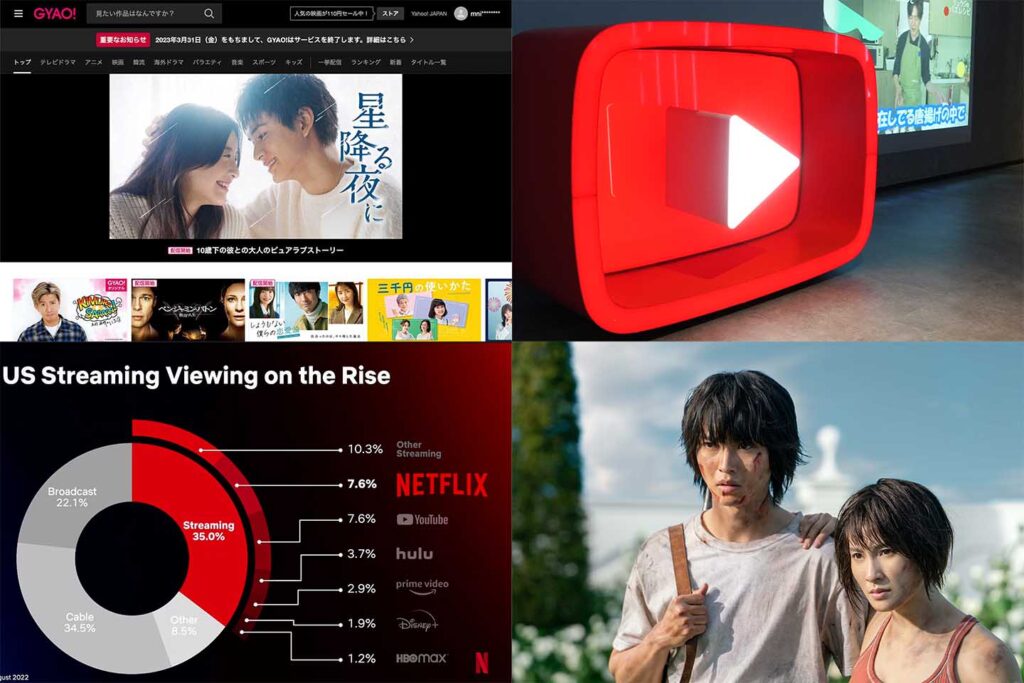Why does the long-established online video “GYAO!”

The video distribution service “GYAO!” will end at the end of March.
GYAO! started service in 2005is a service with a very long history. YouTube started in 2005 as well. Netflix, the world’s largest video distribution company, was launched in 2007.
Considering that, it can be said that it was an extremely advanced service at the time.
However, in the current video distribution, GYAO!’s presence has faded.
Why?
Let’s take a moment to think about the current state of video distribution.
What kind of service is GYAO!
GYAO! (written as GyaO when it started) started in 2005 as mentioned above.
The catchphrase at the time was “Completely Free PC TV”. USEN, which was a broadband network business, started as a service to make use of high-speed lines.
Although the idea was straightforward, it was undoubtedly advanced. However, it is also true that it was fashionable to start this kind of service in Japan. Yahoo! JAPAN also started “Yahoo! Video” in 2003, and NTT East started “FLET’S On Demand” in 2001, even before that.
GyaO has actively developed content and strengthened its brand power. However, profitability continued to struggle. At that time, it was difficult to secure enough profitability to maintain the platform with PC alone.
As a result, it was separated from USEN in 2009 and became a subsidiary of Yahoo! JAPAN, Japan’s largest portal. The current GYAO!
GYAO! has also developed paid services, but many users were watching advertisements and free of charge. Below is an interview I conducted in 2017, but there is no doubt that they also considered it as a strength.
There is one big reason why GYAO! has been able to continue its business.
It means that he was involved in a lot of “official distribution”.
Missed delivery of TV programs is not uncommon nowadays. However, until the early 2010s, services that provided TV programs as content were rare.
However, there are many people who want to see it. That’s why there were a lot more people than now who were illegally uploading programs to video-sharing sites and searching for them to watch.
As a countermeasure, GYAO! was contracted for distribution. Although the ratio is small, the TV station has invested and has established a firm position.
GYAO pressed by TVer and ABEMA’s YouTube rivals!
Such GYAO!
There are two reasons. And the two are interrelated.
The first is the spread of other services for “missed delivery”. Commercial broadcasters strongly promoted “TVer”, a ride-sharing service, and at the same time, the use of YouTube increased. There are also emerging forces like ABEMA.
The second is the delay in responding to smartphones. Smartphone apps have been provided since the early days, but Yahoo was also a highly recognized service on PCs. As a result, in terms of awareness and usage among the smartphone generation, there may have been times when other services were pushed out from the start.
Below are the results of a questionnaire survey on “TVer recognition” announced on December 5, 2022 by NTT Docomo’s “Mobile Society Research Institute”. GYAO! is already far behind YouTube and TVer in terms of recognition and usage rate, and ABEMA is at the same level.
According to the survey report, TVer’s awareness rate is rapidly increasing from 46.4% in 2019 to 72% in 2022.
There is no doubt that the increase in rivals and the expansion of recognition have put GYAO!’s business in jeopardy. It is no longer necessary to choose GYAO! just for missed delivery, and it has become necessary to rely on original content, but ABEMA, an emerging force, is gaining strength. Opportunities to see the name of GYAO! in news etc. were decreasing.
If that’s the case, rather than pouring resources into similar businesses, we should concentrate on “LINE VOOM”, a vertical short video on smartphones, which is a completely different direction.
LINE, which covers the entertainment area with Z Holdings, has also decided to end the live video distribution services “LINE LIVE” and “LINE LIVE-VIEWING”. We are in the process of concentrating management resources on vertical video.
Overwhelming “YouTube” in Japan Approaching commercial broadcasters on TV
On the other hand, in the midst of these changes, we must not forget the “strength of YouTube”. Rivals including TikTok are strong in the form of vertical and short, but other video services are no match for YouTube in the sense that they are seen by a wide range of generations. Even in the usage rate survey mentioned above, it can be seen that only YouTube stands out.
Especially in Japan, the usage rate of YouTube is overwhelming even on “TV”.
According to the information I obtained from interviews with TV manufacturers, etc., it is known that “Most of the time used for video distribution within TV devices is consumed by YouTube.” Amazon Prime and Netflix have a high share of paid services, but even if you add them all up, you can’t beat YouTube.
Since it is not public data, I will avoid direct introduction, but the daily viewing time of YouTube on TV exceeds 40 minutes, which is in line with the viewing time of NHK and commercial broadcasters.
Of course, this is for YouTube as a whole, so it’s actually subdivided by channel/distributor. However, since this amount of time is consumed only by TV, there is no doubt that it will be a difficult time when smartphones are also included.
Under such circumstances, it is quite difficult to compete based on official content. Aside from TVer and AMEBA, whose awareness and usage are on the uptrend, it is not surprising that GYAO!, which was probably on the downtrend, is reviewing its business.
Even in the United States, YouTube has not been supported so far. Below is Nielsen data released by Netflix in October 2022. Netflix and YouTube have similar viewing times, and this has been the case for several years.
How long will the peculiar popularity of YouTube continue in Japan? On the other hand, profits from YouTube videos are declining, and in the case of distribution with a large number of staff and high costs, it is difficult to make a profit with a scale of hundreds of thousands of users. .
Netflix attacks Asia leveraging Amazon hits approaching TV Tokyo
On the other hand, in paid video distribution, Amazon Prime Video has an overwhelming share. I heard that the viewing time was approaching TV Tokyo’s share. Services such as Netflix are seen as less than half of that, and Japan continues to be dominated by “YouTube and Amapura.”
Among them, Netflix has set its focus on Asia, where the number of users is growing. Since the increase in the number of users in the US and Europe has reached a plateau, we are paying attention to Asia, where there is still a lot of room for growth. Profit margins have fallen, but the number of subscribers in the Asian region is growing.
Also, as you know, South Korea was the first to break through in terms of content. In Japan as well, viewing of movies based on Japanese anime and comics is growing, especially in Asia, and season 2 of “First Love Hatsukoi” and “Alice in the Boundary” released at the end of the year were big hits. ing.
In particular, Season 2 of “Alice in the Boundary” broke 200 million hours of viewing time in four weeks after its release, setting a new record for a Japanese work. 2 weeks in a rowNetflix Weekly Global Top 10 (non-English series)Winning the top spot and being in the top 10 for 4 weeks in a row is a big deal.
Netflix is struggling to expand its revenue, but Reed Hastings, who has led the company since its founding in 1997, has been promoted from CEO to “Chairman” and COO (Chief Operating Officer) and CPO (Chief Product Officer). Greg Peters joins Ted Sarandos as co-CEO.
Mr. Peters was the person in charge of the Japanese corporation from 2015 to July 2020. I have also been interviewed many times. It may have been because he was personally familiar with the Japanese market, but it may also be because it was difficult to “develop the Japanese market” and it was necessary to allocate top-class human resources within the company. . We’ll see how he steers Netflix.

